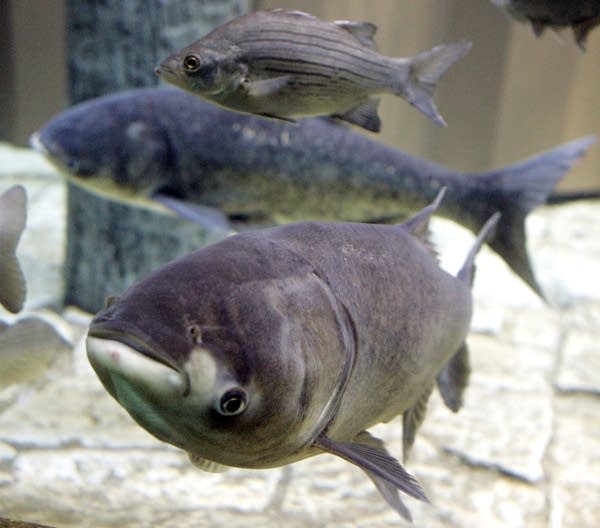DNR tags invasive carp to track movement
Go Deeper.
Create an account or log in to save stories.
Like this?
Thanks for liking this story! We have added it to a list of your favorite stories.

For the first time, the Minnesota Department of Natural Resources has captured and tagged an invasive carp and returned it to the St. Croix River to study its movements.
The agency hopes the fish will provide information useful in its efforts to stop the spread of the species into Minnesota.
DNR staff caught a 37-pound bighead carp in the St. Croix River last Friday. They surgically implanted a tracking tag in its belly and returned the fish to the river.
Nick Frohnauer, the DNR's invasive fish coordinator, said the tag will provide information about the fish's movements and travel patterns.
Turn Up Your Support
MPR News helps you turn down the noise and build shared understanding. Turn up your support for this public resource and keep trusted journalism accessible to all.
"Previously when we captured a fish we only knew that the fish was there at that specific time," he said. "We didn't know if it was hanging out there or passing through, where it came from or where it was going. This will help us gain that."
The tracking information will indicate whether the carp swim around constantly or home in on certain locations, whether they move short or long distances and whether something triggers them to move, Frohnauer said.
The DNR needed authority from the Legislature for the tracking study because it requires putting a prohibited species back into the water. The Legislature granted that authority earlier this year.
The agency is allowed to track up to two fish at a time in the St. Croix, Minnesota or Mississippi rivers. The legislation sunsets in 2021.
The information from the tracking device should help DNR monitoring crews be more efficient, Frohnauer said, guiding them to locations they didn't know carp were.
Other states are doing similar tagging studies, including Illinois, Iowa and Missouri. Frohnauer said Minnesota is unique because it doesn't have a large population of invasive carp yet.
"We've only caught individual fish up to this point," he said. "But if there are any in the area, maybe they'll start to school. They'll get together in a group, and that would allow us to catch additional individuals."
After a period of tracking, the fish will be recaptured and either put back in the water for more study or killed.
Bighead, silver and other invasive carp have been making their way upstream since escaping into the Mississippi River in the 1970s. These large fish compete with native species and pose a threat to rivers and lakes.
While no breeding populations have been detected in Minnesota waters, individual fish have been caught in the Mississippi near the Twin Cities, the St. Croix River and the Minnesota River.
Earlier this summer, an angler fishing a private gravel pit within the Minnesota River floodplain near Redwood Falls caught a bighead carp measuring nearly 4 feet, the largest ever captured in Minnesota.
Dear reader,
Political debates with family or friends can get heated. But what if there was a way to handle them better?
You can learn how to have civil political conversations with our new e-book!
Download our free e-book, Talking Sense: Have Hard Political Conversations, Better, and learn how to talk without the tension.



